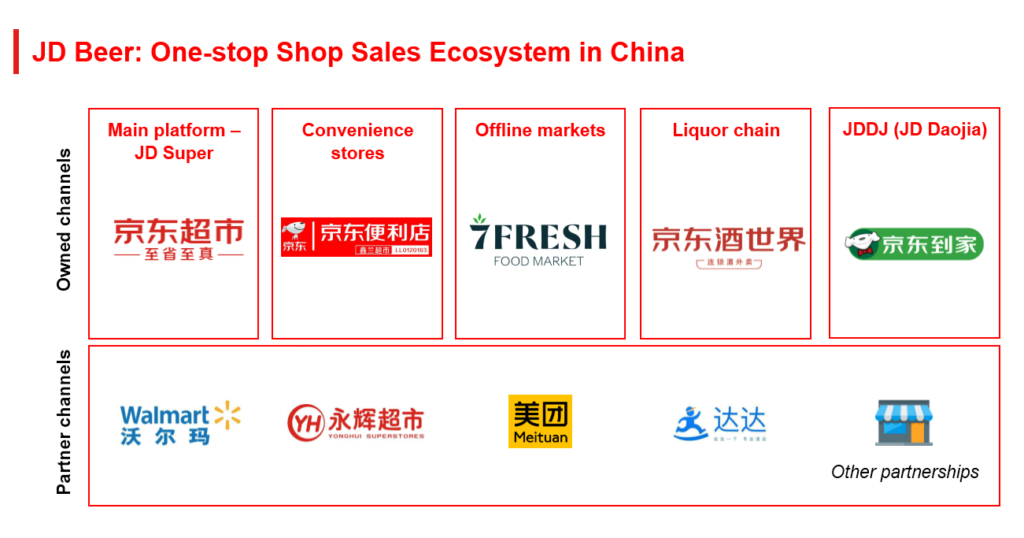Jun 17, 2020|
In-depth Report: With JD, International Beer Brands Seek New Growth in China
by Ella Kidron
The boom that the fast-moving consumer goods (FMCG) e-commerce sector experienced in the first quarter of this year looks here to stay. With it, China’s online beer market is also getting a boost.
Consumers turn to JD Super during COVID-19, keep coming back during 618
The outbreak of COVID-19 impacted many brick-and-mortar establishments, leading e-commerce platforms around the world to take on the role of friendly neighborhood supermarket. JD’s FMCG-related e-commerce business saw a rapid increase in the first three months of this year, which has continued into 618.
As shared by Sidney Huang, who just stepped down as JD’s CFO on May 31st, on the first quarter earnings call* this year, “Category-wise, revenue growth of general merchandise accelerated to 38%, the highest growth rate for the past six quarters, driven by our newly integrated omnichannel supermarket business group, growing 47% in the first quarter as well as strong performance from healthcare, cosmetics, and household product categories.”
Before COVID-19, JD was already the largest retailer in the supermarket category, no matter if you look online or offline. As also shared by Huang during the Q1 earnings call, “By 2019, the revenues of this group reached over RMB115 billion, roughly 20% higher than the revenues of the largest offline supermarket chain in China, making us the largest retailer for this category in the country.”
On the first day of JD’s 618 (June 18th) Grand Promotion, June 1st, sales of JD’s online supermarket, JD Super, doubled as compared with last year and transaction volume in the beer category in five minutes , was 10 times that of last year while craft beer transaction volume in 10 minutes reached 10 times sales of last year.
During 618, JD Global PR sat down with Alexander Kremer, a director in JD’s FMCG Omnichannel division, which is led by Carol Fung, “Queen of FMCG”, for a chat on Twitter Live (see the full video here). The initial discussion inspired a deeper discussion to understand JD’s beer division, and the company’s role in driving market trends.
Market opportunity for international brands
China is one of the largest beer markets in the world, with annual consumption of over 45 billion liters – nearly five times as much as what Germany, the storied home of beer and the largest beer market in Europe, consumes, and twice as much as the United States alone, according to Euromonitor. The Chinese beer market has been growing rapidly over the years, even as the volume of the overall beer sector has decreased. Future growth is expected to be driven by the introduction of more premium and craft beers in China’s beer market. This means a huge opportunity for international brands looking to break into China.
As Kremer explains, “Usually it makes sense to go where the trend is. JD’s beer category has experienced rapid growth and global brands are growing with us.” According to Euromonitor, international brands account for 7.2% (in terms of liters) of beer consumption in the Chinese market. While this number relatively small and increasingly steadily, international brands are already hugely popular on JD.com, and account for 60% in terms of liters of beer sold on the platform.
For international brands looking to the Chinese market as their next growth avenue, JD offers an online channel with unlimited product selection covering the whole country.
As for how to win the hearts of Chinese consumers? “Trust goes a long way,” said Kremer. “Our first party retail model goes along with a lot of trust. When consumers buy on JD, they know they are buying authentic products and they can trust it.
Undeniable importance of logistics
Strong logistics are especially important for alcohol in China. “A lot of people buy rather larger quantities of alcohol online – above US$20 per order on average. JD Logistics is able to deliver to consumers in many places in China within 24 hours, which is really convenient compared with lugging 10 kg of beer home from the supermarket,” said Kremer. JD’s nationwide logistics network which consists of over 730 warehouses, is an important part of making this convenience a reality.
It needs to be almost as convenient if not more convenient to order alcohol online than to pick it up from the store. Kremer said: “Customers don’t want to place an order and wait three days. That’s not how most people buy groceries and consumer goods. When you buy online, we want to make it as convenient if not more convenient.” This is one of the reasons that the team places such an emphasis on omnichannel.
“JD understands that for alcohol brands, online is important and is a growth channel for sure, but that they are also interested in other channels, on-trade (bars, restaurants, etc.) and off-trade (supermarkets and other places where alcohol is purchased but not consumed on site). We can provide brands an extension into traditional retail channels as well,” said Kremer. JD operates 7FRESH, a high quality omnichnanel supermarket brand with countless imported products – consumers can opt to go to the store or order for delivery within as fast as 30 minutes.
There are currently 22 7FRESH stores nationwide. Beyond that, JD also operates JD Alcohol – a chain of more than 1,500 offline stores where quality tobacco and alcohol are sold. JD’s New Markets initiative also expands brands’ access to convenience stores across China. Finally, JD has been working for long on a closer integration between JDDJ (JD Daojia), the one hour from-supermarket-to-home delivery service, and the online JD Super channel. As a result, customers searching for beer through the JD Super channel will also see the products available in the closest traditional supermarket nearby – to be delivered within one hour. While in the JDDJ channel, customers also get cross-references to the JD Super channel if they aim to buy large quantities of the same brand.

JD Beer ecosystem in China, including owned and partner channels
A 7,000 year old industry seeks new
Kremer explained, “One might think that for such a historic industry, there isn’t much going on. But, in fact there’s a ton of innovation.” Beer is in fact one of the oldest (believed to be some 7,000 years old) and widely consumed beverages in the world, ranking third, only after water and teaCraft beer, which started becoming popular in China a few years ago, remains a hit among consumers, especially those looking for a more premium brew to be enjoyed leisurely.
Another relatively new phenomenon? Can/bottle size innovation. A few years ago, beer largely came in 500 ml of 330 ml cans or bottles, but now there are new bottle shapes, as well as varying sizes of bottles or cans, such as craft beer served in 1L bottles, almost like wine. Another thing which has not yet hit the market in China, but Kremer thinks could eventually become popular? An at-home tap beer machine. “You can bring beer to your home in 2, 3 or 5L kegs, and enjoy draft beer at home. More and more people are emphasizing the need to enjoy beer in the freshest possible way,” said Kremer.
In China, a rise in consumption of beer by female consumers is also driving JD to offer new flavors. Whereas traditionally male consumers might have been the primary decision makers in buying a lot of alcohol, including beer, now female consumers are more excited about buying it. In recent years, the share of female consumers as a proportion of total transaction volume has gone from around 20% to almost 30%. As a result, JD provides some lighter, softer tasting products, such as beers mixed with other beverages. At the same time, consumers in general are increasingly health conscious and gravitate towards lower calorie beers.
JD is doing its part to get ahead of the trends in the China market through its Consumer-to-Manufacturer (C2M) initiative where it uses data insights to develop new products. In the beer category, JD works with brands to analyze search terms, product reviews and other content people post on the platform as well as sales data, and based on that provides suggestions to brand partners about products which might do well with Chinese consumers. One C2M project, based on the analysis of millions of customer interactions (search, comments, etc.) with a major brewery led to a relaunch of the brand’s packaging. When it comes time to introduce these products on the market, livestreaming provides an exciting way to do so.
JD Bar goes live
According to Kremer, sales of beer online through livestreaming started two years ago, but gained a lot of traction with COVID-19. Many of JD’s livestreams for beer brands and other alcohol products are appropriately hosted at the JD Bar – a makeshift bar in the JD HQ regularly used by the team for events and tastings. “Beer, alcohol and other consumer goods can sometimes be really complex products. JD’s platform offers an amazing selection of goods, but how to differentiate and explain certain trends, or advocate why spend more for a premium product, is a challenge. Livestreams allow us to talk about the products history, consumption habits, and unique qualities.” JD recently hosted a “livestreaming clubbing” session for a handful of German beer brands. An initiative that came into being during the height of COVID-19 as a way to help brands market their products, while providing unique entertainment for consumers, JD’s livestreaming clubbing has become a mainstay on the platform.
Livestreaming is one of several ways that JD is able to provide visibility to brands. Through its strategic partnership with Tencent, as well as with content providers such as Kuaishou – the e-commerce giant has recently inked a new partnership where customers will be able to watch livestreams on Kuaishou and buy products from JD without leaving the Kuaishou app – JD is able to expand the ecosystem in which brands have visibility in the China market beyond itself to other channels. This year JD is hosting 300,000 livestreams during the 618 Grand Promotion, of which 70,000 are from JD Super. “What’s really interesting is it’s not just us and celebrities, but many times we also combine with brand reps for livestreams,” said Kremer. “It really becomes a form of co-creation between the brand, us as a platform and (internet) celebrities.”

A recent livestream clubbing session hosted by JD Beer to promote German beers
In just a few short days JD’s 618 Grand Promotion will come to an end but work is far from over for the beer team. Just around the corner is JD’s beer festival held from July to August, which can be thought of as an online version of Oktoberfest, the infamous beer festival that originated in Southern Germany and become famous worldwide. The festival will see extra marketing campaigns and very attractive deals. “A lot of people shop on our platform because they are excited about discovering new brands, products they can’t find in supermarkets, bars, restaurants,” explained Kremer. The upcoming beer festival will serve as yet another opportunity for international brands to gain visibility among Chinese consumers, as well as a chance for consumers to taste the latest and greatest in beer from all around the world.
*All earnings call statements are under a safe harbor statement, available here: http://ir.jd.com/news-releases/news-release-details/jdcom-announces-first-quarter-2020-results





 This Harbin tourism boom has also spurred a surge in sales of winter apparel. JD.com’s data indicates a rapid growth in the sales of warm clothing items such as down jackets, snow boots, and thermal underwear between January 1st and 7th. The sales growth is especially pronounced in southern provinces and cities such as Jiangsu, Zhejiang, Guangdong, Sichuan, and Shanghai. Notably, tall snow boots registered a 206% year-on-year increase in transactions, while padded cotton caps and thickened long down jackets soared by 158% and 134%, respectively. Beyond clothing, travel gear has also seen a considerable uptick, with a 98% year-on-year growth in transactions for large suitcases and travel backpacks in these southern regions.
This Harbin tourism boom has also spurred a surge in sales of winter apparel. JD.com’s data indicates a rapid growth in the sales of warm clothing items such as down jackets, snow boots, and thermal underwear between January 1st and 7th. The sales growth is especially pronounced in southern provinces and cities such as Jiangsu, Zhejiang, Guangdong, Sichuan, and Shanghai. Notably, tall snow boots registered a 206% year-on-year increase in transactions, while padded cotton caps and thickened long down jackets soared by 158% and 134%, respectively. Beyond clothing, travel gear has also seen a considerable uptick, with a 98% year-on-year growth in transactions for large suitcases and travel backpacks in these southern regions. JD Deploys Asia’s First Integrated Smart and Flexible Production Logistics Park in Tianjin
JD Deploys Asia’s First Integrated Smart and Flexible Production Logistics Park in Tianjin



